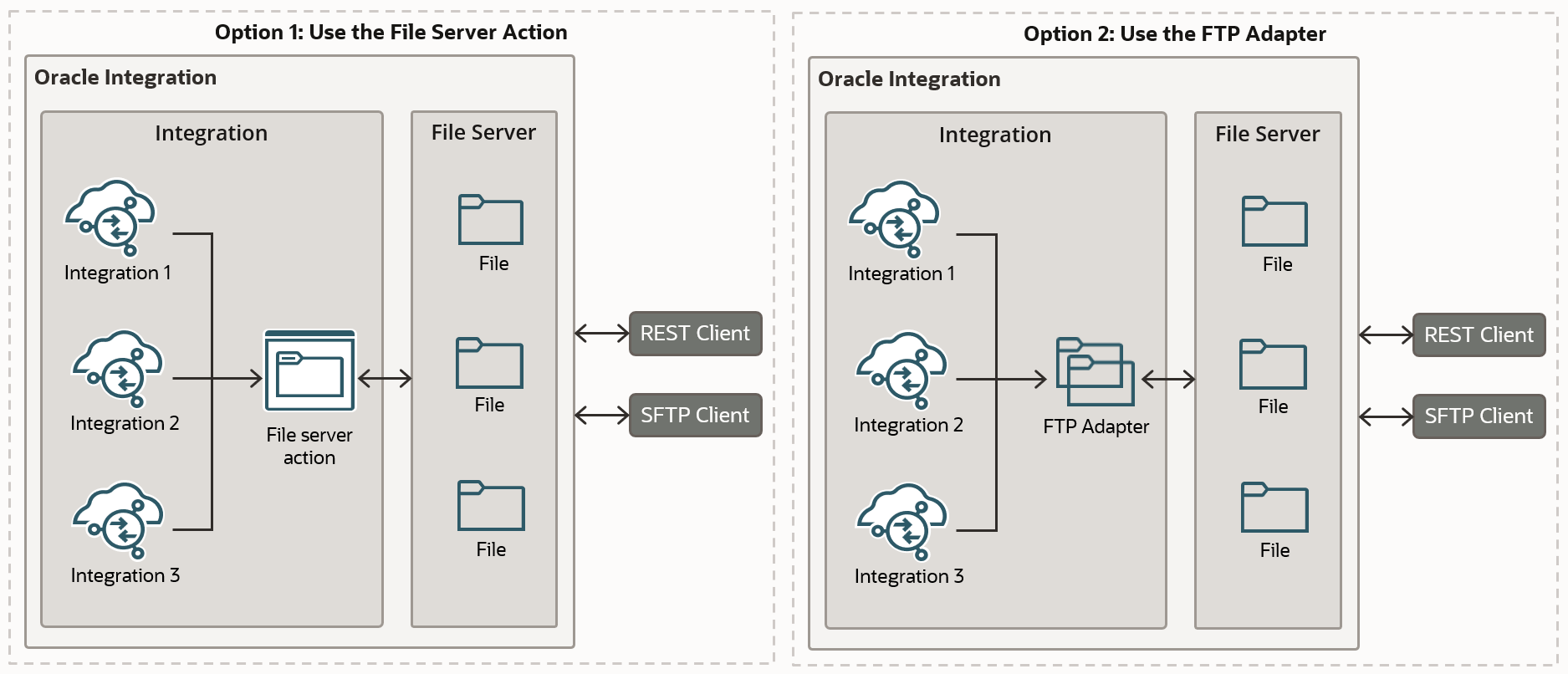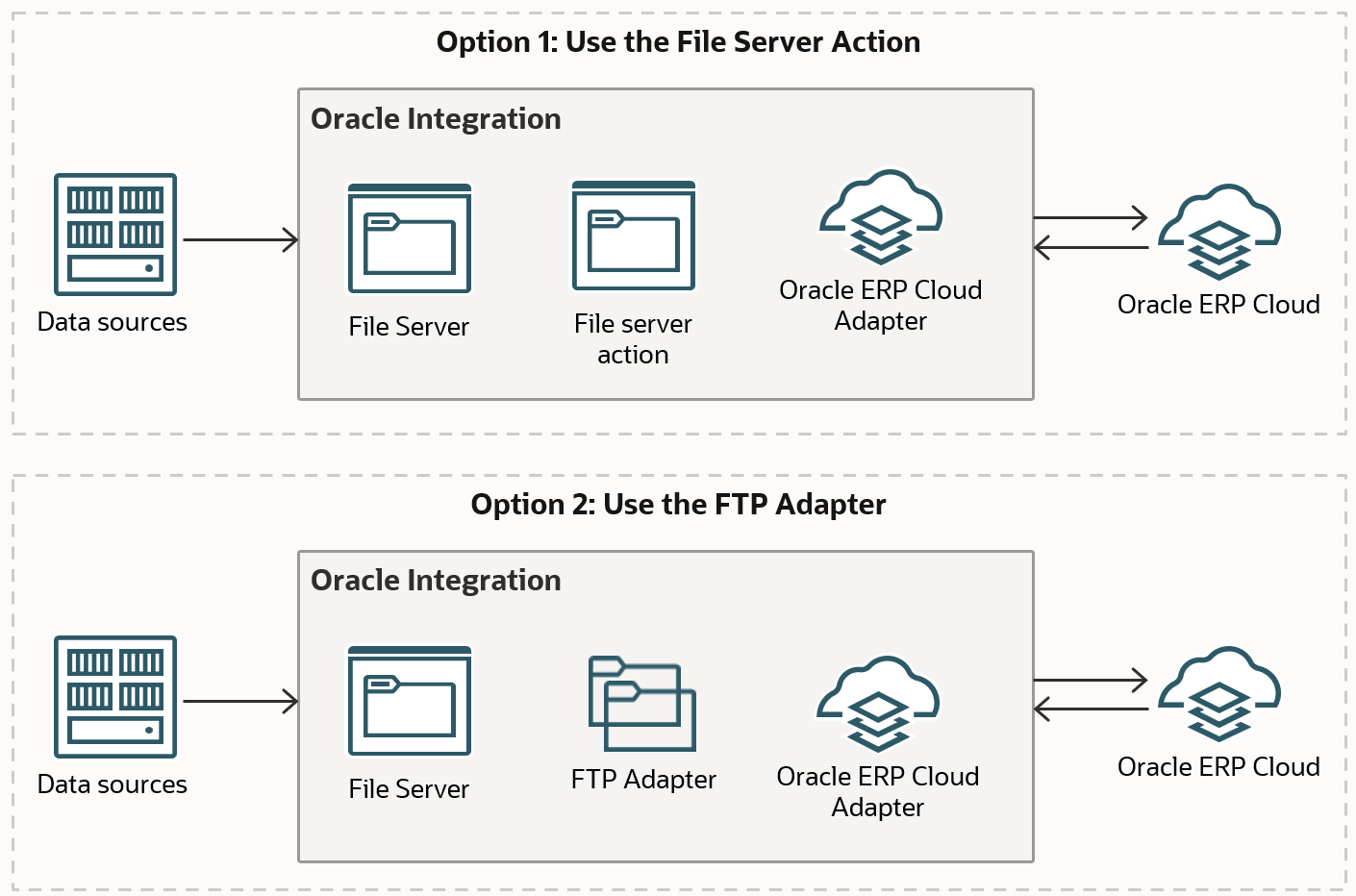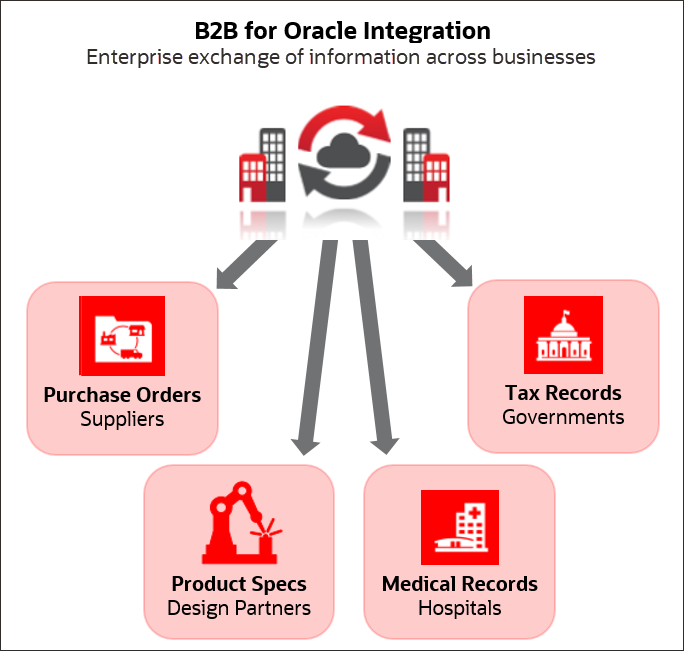Connect to Everything
Oracle Integration solves the application silo problem. It brings together data and workflows between disparate software applications for them to function as one.
Oracle Integration provides several tools for automating business processes, including integrations and robots, which perform this work in different ways:
-
An integration gets information from an application by calling its APIs.
-
A robot gets information from an application by opening the application and completing a task in the user interface as a person does.
Integrations and robots deal with live operational data. Data can be processed either in real-time or in batch, and between two or more applications, events, or application programming interfaces (APIs).
Deployment Flexibility
With integrations and robots, you can connect to anything without getting bogged down in technical implementation details.
You can bring data and applications together across on-premise and cloud systems: cloud to cloud, cloud to on-premises (ground), and on-premises to on-premises (ground to ground).
Library of Prebuilt Adapters
When you develop an integration from scratch, your first task is to create a connection for each application that you're going to connect to. The connection defines how you’ll connect to the application. When you create a connection, your first step is to select an adapter.
An adapter provides the means for Oracle Integration to connect to different applications. After you choose an adapter, you provide the information that lets the adapter successfully find and connect to a particular instance of an application. The information might include the application URL, the security policy to use, and the credentials for signing in to the application.
Oracle Integration includes dozens of prebuilt adapters that make it easy for your integrations to connect to a range of Oracle and third-party applications, including applications that handle your customer relationships, human resources, supply chain, resource planning, e-commerce, social media, and databases. Also, the FTP, REST, and SOAP adapters let you use standard file, web, and messaging protocols. And all adapters let you connect to applications that are on-premises or in the cloud.
For a full list of adapters currently supported by Oracle Integration, see Adapters. New adapters are added all the time.
The Rapid Adapter Builder
The Rapid Adapter Builder in Oracle Integration enables you to build an adapter for any application that exposes RESTful APIs, without having to develop complex code from scratch.
As discussed in the previous section, Oracle Integration has an ever-growing library of application-specific adapters that you can readily use for your integration scenarios. However, when an Oracle-provided adapter is not available for your purpose, you can build your own adapter using the Rapid Adapter Builder. It provides all the necessary infrastructure to build adapters for Oracle Integration. An adapter built using the Rapid Adapter Builder can offer the same capabilities as an Oracle-provided adapter. You can implement behaviors similar to those available in the existing adapters on Oracle Integration.
The Rapid Adapter Builder is available as a Visual Studio Code (VS Code) extension, which helps you generate the code required to build an adapter. Using this extension, you can iteratively develop your adapter and publish it to Oracle Integration. See Using the Rapid Adapter Builder with Oracle Integration 3.
Integration Recipes and Accelerations
You don't need to develop an integration flow or use case from scratch. You can install ready-made integration recipes and accelerators from the Home page.
Recipes and accelerators are collectively known as prebuilt integrations. Recipes are sample use cases that give you a head start. Accelerators are run-ready business integrations or technical patterns of larger scale.
When you install a recipe or an accelerator, it's installed as a package or project. The package or project contains all the resources you need for an application-integration scenario. The resources it contains include one or more integrations flows and dependent resources, such as, connections, certificates, lookups, and libraries.

Description of the illustration acc-recipe.png
For a full list of recipes and accelerators currently available for Oracle Integration, see Recipes and Accelerators in the Oracle Help Center. The collection is growing all the time.
Embedded File Server
Use File Server to store files or transfer real-time data among applications securely. File Server provides an embedded Secure File Transfer Protocol (SFTP) server within Oracle Integration, so you can focus on building integrations without needing to host and maintain a separate SFTP server.

With File Server, you can:
-
Design integrations that process your files that reside in the embedded file server.
-
Eliminate the cost and operational expenses associated with hosting and maintaining an SFTP server by moving your SFTP server to the cloud. If you have an on-premises SFTP server, then you can move your SFTP files into File Server in Oracle Integration and use the SFTP adapter to connect.
-
Give your vendors or partners access to Oracle Integration to upload and download files with their SFTP client software. A common protocol for communication with partners is SFTP. File Server enables partners to send information such as purchase orders, invoices, shipping information, and so on through SFTP.
Example: Read, Transform, Write
For example, if you have applications that export bulk data to an SFTP server, Oracle Integration can pick up the file, translate it into the required format, and send it to the target system. For instance, E-Business Suite generates a zip file with external transactions and uploads it to File Server. An integration can then read the file, transform it into the format required by the ERP system, and trigger bulk import of the data.
You have two options for connecting to File Server: the FTP Adapter and the File server action.

Business-to-Business Communications
B2B for Oracle Integration provides support for business-to-business (B2B) e-commerce. You can communicate with trading partners, and send and receive data in integrations with B2B.

Description of the illustration b2b-concept.png
B2B for Oracle Integration lets you:
-
Securely exchange business documents, such as purchase orders or product specifications, with your trading partners using standard Electronic Data Interchange (EDI) formats.
-
Securely exchange outside the enterprise with your trading partners.
In B2B e-commerce, an enterprise extends its business processes to reach trading partners, for example, suppliers, manufacturers, hospitals, and government agencies. B2B e-commerce represents classic business processes, mature business documents, and industry-tempered messaging services. It requires a unified business process platform, end-to-end instance tracking, visibility and auditing, integrated process intelligence, process and service governance, and centralized security.
Connect to Healthcare Systems
Use Oracle Integration for Healthcare to integrate business and health data using industry standards such as Health Level Seven (HL7) and Fast Healthcare Interoperability Resources (FHIR) with Oracle Integration. To use Oracle Integration for Healthcare, you provision a Healthcare edition of Oracle Integration from the Oracle Cloud Infrastructure Console.
- Healthcare HL7 message and schema editor
- Customize HL7 version 2 message schemas with the built-in editor.
- Start with any standard HL7 version 2 message and add or remove segments, fields, repeating elements, and so on.
- Use preloaded, standard HL7 message schemas (versions 2.3.1 through 2.9).
- Healthcare action
- Parse, validate, and transform native HL7 messages in your integrations with a healthcare action in the integration canvas.
- FHIR Adapter
- Consume external FHIR resources from your integration.
- Define and invoke the remote FHIR API through a simple wizard-driven approach.
- Perform create, read, update, delete, and search operations.
- MLLP Adapter
- Allows bidirectional (trigger and invoke) connections supporting the TCP-based MLLP protocol.
- Supports native transport of HL7 version 2 messages.
- Extended data retention
- Supports activity stream data retention for six months.
See Introduction to Oracle Integration for Healthcare in Using Oracle Integration for Healthcare in Oracle Integration 3, FHIR Adapter Capabilities in Using the FHIR Adapter with Oracle Integration 3, and MLLP Adapter Capabilities in Using the MLLP Adapter with Oracle Integration 3.
Connect to Oracle SOA Suite
If you currently use Oracle SOA Suite (either on premises or in the cloud using Oracle SOA Cloud Service or Oracle SOA Suite on Marketplace), adding Oracle Integration to your setup unlocks new features and capabilities.
-
Oracle SOA Suite is a customer-managed deployment that is available either on-premises or in Oracle Cloud Infrastructure.
In contrast, Oracle Integration is an Oracle-managed PaaS platform. With Oracle Integration, Oracle manages responsibilities such as upgrades, patching, high availability, performance tuning, and scaling.
-
Oracle Integration provides a rich set of SaaS adapters to connect natively to Oracle SaaS applications (both on premises and in the cloud).
These include Oracle Cloud ERP, Oracle Cloud HCM, Oracle E-Business Suite, Oracle CX Sales and B2B Service, and others. See the Adapters page on the Oracle Help Center for the growing list of Oracle Integration adapters.
-
Oracle Integration provides a low-code platform where you can easily build drag-and-drop integrations between cloud and on-premise applications.
To retain your investment in Oracle SOA Suite, you can connect your existing SOAP-based and REST-based composite applications to Oracle Integration. Creating the connection is easy using the connectivity agent and Oracle SOA Suite Adapter. Then, you can develop new integrations in Oracle Integration that connect your existing Oracle SOA Suite composite applications to other products and services. Over time, you can reimplement your Oracle SOA Suite composite applications and artifacts in Oracle Integration. See:
-
Oracle SOA Suite Adapter Capabilities in Using the Oracle SOA Suite Adapter with Oracle Integration 3.
-
About Creating Hybrid Integrations Using Oracle Integration in Using Integrations in Oracle Integration 3.
Note:
If you are using Oracle SOA Suite on-premises, you can reduce your overhead by moving fully to the cloud. Migrating to Oracle SOA Suite on Marketplace provides a Platform as a Service (PaaS) computing platform solution for running applications in the cloud. It includes a complete set of service infrastructure components for designing, deploying, and managing composite applications. See Differences Between Oracle SOA Suite On-Premises and Oracle SOA Suite on Marketplace in Oracle SOA Suite on Marketplace.For documentation about the Oracle SOA Suite offerings on different platforms, see Oracle SOA Suite on the Oracle Help Center.


